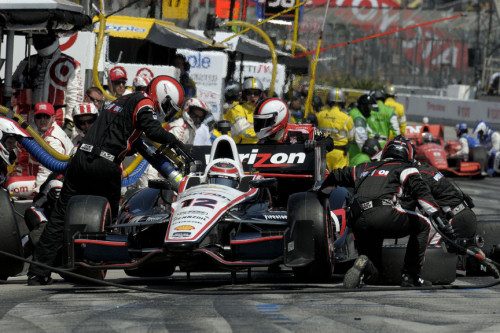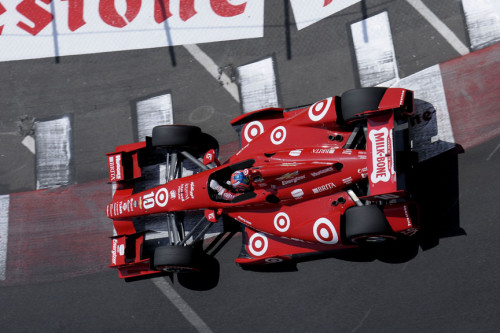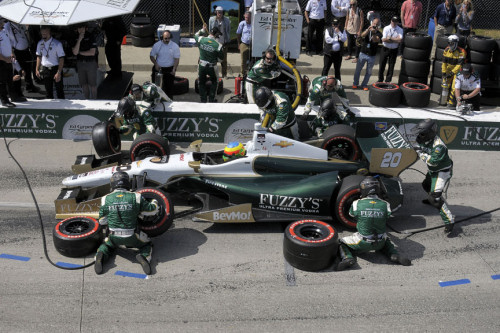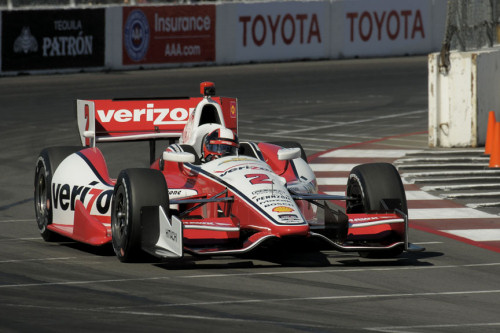The Way It Is/ The latest on Chevrolet's Indy engine programby Gordon Kirby |
 Chevrolet has won IndyCar's manufacturer's championship the past two years and its engines were able to win the opening two races of this year at St. Petersburg and Long Beach. But as always there's plenty of competition from Honda whose engines won nine races last year, only one less than Chevrolet. Honda also took pole position for both races run so far this year and swept five of the top six in qualifying at Long Beach.
Chevrolet has won IndyCar's manufacturer's championship the past two years and its engines were able to win the opening two races of this year at St. Petersburg and Long Beach. But as always there's plenty of competition from Honda whose engines won nine races last year, only one less than Chevrolet. Honda also took pole position for both races run so far this year and swept five of the top six in qualifying at Long Beach.
This is the third year for IndyCar's 2.2 liter turbo V6 formula. IndyCar requires twin turbos this year as Chevrolet has run from the start while Honda used a single turbo the past two years. This year's engine rules also permit substantial changes to the top end of the turbo V6s and both Chevrolet and Honda have produced essentially new engines for the new season. "The rules allowed you to change everything from the fire face up, so we did," commented Ilmor's veteran chief engineer Steve Miller. "We had to maintain the cylinder head casting. You weren't allowed to change the raw material for the head but, that aside, you could do anything you liked. "We changed the fuel system, the injectors, a new plenum, new inlet system, new throttle system, different ports, changed the valve sizes, new cams and valve springs. There have also been a few detail changes to the spec turbo from last year." MIller pointed out that piston development remains unfettered. "The pistons are free and are under continuous development," he noted. "You're always diddling around trying to get that little bit extra because it's a free component to develop and you have to replace them at every rebuild anyway. We make all the pistons at our manufacturing facility in Detroit."  © LAT/Paul Webb "If we had our ideal choice we would have preferred a more metered rate of change but it's just the way it worked with the homologation table for this winter," Miller said. "It's now pretty well set for the next three years. This is one of the downsides of having the homologation table, it compels us to back off a bit." This year's IndyCar engines make a little more noise than the last two years. The engines are quiet by traditional F1 standards but make more sound than the latest turbo F1 engines. "I think it's an acceptable level of sound," Miller commented. "It doesn't hurt your ears and I think in today's world we've got to accept that racing engines must be quieter than we've heard in the past." Both Chevrolet and Honda IndyCar engines produce between 550 and 700 horsepower depending on the boost level. More boost and power is permitted of course on road and street circuits than ovals. "We end up calibrating for four different boost pressures," Miller observed. "The push-to-pass boost is at 1.6 bar and there's 1.5 bar boost on the road circuits, 1.4 on the mid-sized oval and 1.3 on the superspeedways. So when you put all that stuff together with the fact that you've got port injection and direct injection you end up with a huge matrix of calibration. We burn an awful lot of fuel on the dyno working it all out. "The performance is good," he added. "And the reliability is good. As I said, we've spent a lot of money proving out the calibrations, but it's working pretty well." A big challenge for the engine manufacturers this year is meeting IndyCar's increased mileage requirements. Chevrolet's IndyCar program manager Chris Berube discussed the mileage limits. "One of the changes for 2014 is the engines have to run 2,500 miles between changes," Berube commented. "That's a 25 percent increase over last year. I've got to applaud the work that was done to meet that requirement in our validation phase and then produce power and performance upgrades at the same time. Normally, those things are traded off. "We have yet to prove it on the track but that is the challenge for this year, to be more durable from a mileage standpoint and always looking for more power and performance." Miller pointed out that IndyCar's testing restrictions mean it's impossible to put 2,500 miles on an engine in testing.  © LAT/Paul Webb "In the old days," Miller added, "250 miles got you there in most races. You needed 200 miles in the race and fifty miles in the warm-up and sometimes you didn't get that far." Miller says GM's transient dyno has been essential in developing Chevy's engines to last 2,500 miles. "Working on the drivability stuff at the transient dyno at GM in Troy has been very important," he stressed. Added Chris Berube: "It's been invaluable because the amount of testing you can do is very limited by IndyCar. So we find out what we can do through either true simulation or the transient dyno." Chevrolet has a pool of around 45 engines in total. "We have ten full season cars and ten engines in service at any time with some in rebuild," Berube commented. Ilmor's North American boss Paul Ray says managing the supply of engines for the month of May can be logistical test. "Indy is always the biggest challenge," Ray said. "You have practice engines and race engines, and you look at all that very carefully. You want to roll out of Indy with four engines for the rest of the year so Indy becomes your bottleneck." Berube says Chevrolet's engineers play an important role in achieving the best possible engine installation for maximum efficiency and drivability. "A big part of our effort is integration into the car and achieving the best drivability," Berube commented. "The competitive space between us and Honda is how can you get this power to the ground and tailor it to each driver's driving style? A lot of work goes into doing that part of it and keeping it cool in the car. Those are important parts of winning on the track." Miller says he's learning to live with IndyCar's complex engine rules.  © LAT/Paul Webb Miller believes IndyCar must put more effort into communicating the relevant technology in today's IndyCar engines to its fans and media. "A fundamental attraction to General Motors for being involved in this sport was the road relevance of the regulations," Miller said. "It was very attractive to GM to work on things like direct injection and small capacity turbos that can feed technology and methods of working back to the road car side. "I think there's some extra effort required to make all the IndyCar viewers understand the technology that's in the engines. I'm not sure the fans in the stands are engaged in the production relevant technologies that are in the engines and I think IndyCar should put more effort into communicating what we're doing with this technology." Berube said GM believes there's some marketing value in racing engines that are relevant to today's production cars. "Small displacement V6s are just like our production cars," Berube said. "Turbocharging and running E85 fuel are all directions that we are being forced to go by increasing fuel economy requirements. It's very easy for the fan to relate to." Berube emphasized the importance to GM of using racing to develop the skills and motivation of its engineers. "We also use racing as a proving ground for people," he stressed. "My presence here, for example, is to get some experience in motor sports and to go back to the production side of General Motors to make use of what I've learned here. We've got some engineers embedded in the program on the Ilmor side and that's an important element in why we do this. "We use GM resources like the transient dyno and other advanced engineering capabilities to develop our Indy engines and that provides us with a lot of data and information that we can apply to the production car business." Our conversation led us to a discussion of energy recovery systems and whether or not they have a place in IndyCar's future. We all know energy recovery systems are expensive and complex and because of these factors we may never see this technology in IndyCar.  © LAT/Paul Webb Miller also mused on whether or not energy recovery systems have a place in IndyCar. "IndyCar are considering a whole spectrum of possibilities and as Chris said the basic decisions center on cost and complexity," he said. "I think to some extent you widen the gap between the front and back of the field because the smaller teams would struggle with that stuff. "Interestingly enough, the energy recovery systems are probably most responsible for the lack of sound and appeal of this year's Formula One cars. It all exhausts into a pretty small hole dictated by the turbocharger. Racing still needs to be a gladiatorial sport, doesn't it? That's what people pay to come to see. It's not about people playing chess. "As an engineer, you'd love to play with these energy recovery systems because there's a wider range of possibilities. But it's a bit like when you read so many corporate websites and they tell you they are green responsible. But they don't tell you that their primary objective is to make money. "I do think we have to be aware of what will be a good direction to head," Miller concluded. "But you definitely have to make the right decisions as far as fan appeal and also cost for the teams. It will be interesting to see what direction IndyCar decides to go." Can Chevrolet win a third straight IndyCar manufacturer's championship this year? Either way, the company is an important key to IndyCar's hopes for a successful future. |
|
Auto Racing ~ Gordon Kirby
Copyright ~ All Rights Reserved |
